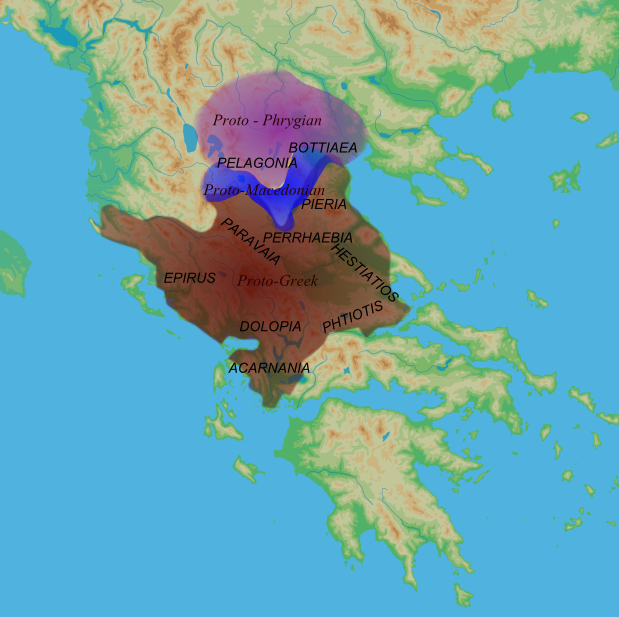Archetype0ne
Regular Member
- Messages
- 1,726
- Reaction score
- 613
- Points
- 113
- Ethnic group
- Albanian
- Y-DNA haplogroup
- L283>Y21878>Y197198
"Heracles, whom Zeus had originally intended to be ruler of Argos, Lacedaemon and Messenian Pylos, had been supplanted by the cunning of Hera, and his intended possessions had fallen into the hands of Eurystheus, king of Mycenae. After the death of Heracles, his children, after many wanderings, found refuge from Eurystheus at Athens. Eurystheus, on his demand for their surrender being refused, attacked Athens, but was defeated and slain."
This IMO is what set in motion the differentiation of proto-Greeks with proto-Albanians. To this day we have genetic difference between Athens and Argos (Achea+Morea) reflecting this split.
"Hyllus and his brothers invaded Peloponnesus, but after a year's stay were forced by a pestilence to quit. They withdrew to Thessaly, where Aegimius, the mythical ancestor of the Dorians, whom Heracles had assisted in war against the Lapidae, adopted Hyllus and made over to him a third part of his territory. After the death of Aegimius, his two sons, Pamphylus and Dymas, voluntarily submitted to Hyllus, who thus became ruler of the Dorians, the three branches of that race being named after these three heroes. Being desirous of reconquering his paternal inheritance, Hyllus consulted the Delphic oracle, which told him to wait for "the third fruit," and then enter Peloponnesus by "a narrow passage by sea."
Supposedly they tried to invade Aechean Greeks 3 times, failing, explaining the ~300 years it took for the Dorian invasion to finally mean anything.
"The Heracleidae ruled in Lacedaemon until 221 BC, but disappeared much earlier in the other countries. This conquest of Peloponnesus by the Dorians, commonly called the "Return of the Heracleidae," is represented as the recovery by the descendants of Heracles of the rightful inheritance of their hero ancestor and his sons. The Dorians followed the custom of other Greek tribes in claiming as ancestor for their ruling families one of the legendary heroes, but the traditions must not on that account be regarded as entirely mythical. " Especially bolded so Markod wont miss it.
Heracles was a slave turned to legendary Hero and King in western Anatolia. Etrusci claimed descent of Heracles. Dorians claimed descent of Heracles. In Virgils Aeneid Apollonia and Ilium (Ancient Epirus) were founded by Troyan refugees, some of which ended in Etruria...
If anyone plans to take my words and to misuse them saying I am implying Etruscans and Proto Albanians as same entity do not even try. Have already posted proof enough that Troy/Ilium was a multi entity league. What is written black and white by Homer, Herodotus, Strabo, Virgil is simply that "some" of the ancestors of modern Etruscans were of the same tribe as the Dardani, and Aenea himself was a Dardan.
If anyone wants additional sources to understand what the hell I am talking about:
https://indo-european.info/ie/Paleo-Balkan_languages
https://indo-european.eu/haplogroup...ion-was-associated-with-proto-indo-europeans/
https://indo-european.eu/tag/wilusija/
https://indo-european.eu/2018/05/co...and-the-potential-anatolian-expansion-routes/
======================================
https://en.wikipedia.org/wiki/Template:Trojan_race
https://en.wikipedia.org/wiki/Iardanus_of_Lydia
https://en.wikipedia.org/wiki/Agron_of_Lydia
https://en.wikipedia.org/wiki/Gyges_of_Lydia
https://en.wikipedia.org/wiki/Ardys_of_Lydia
https://en.wikipedia.org/wiki/Hyllus
https://en.wikipedia.org/wiki/Hyllus_(river)
https://en.wikipedia.org/wiki/Scamander
https://en.wikipedia.org/wiki/Alba_Longa
https://en.wikipedia.org/wiki/Gegania_(gens)
========================
Strabo on the Troad;
Virgils Aeneid;
Homers Iliad;
This IMO is what set in motion the differentiation of proto-Greeks with proto-Albanians. To this day we have genetic difference between Athens and Argos (Achea+Morea) reflecting this split.
"Hyllus and his brothers invaded Peloponnesus, but after a year's stay were forced by a pestilence to quit. They withdrew to Thessaly, where Aegimius, the mythical ancestor of the Dorians, whom Heracles had assisted in war against the Lapidae, adopted Hyllus and made over to him a third part of his territory. After the death of Aegimius, his two sons, Pamphylus and Dymas, voluntarily submitted to Hyllus, who thus became ruler of the Dorians, the three branches of that race being named after these three heroes. Being desirous of reconquering his paternal inheritance, Hyllus consulted the Delphic oracle, which told him to wait for "the third fruit," and then enter Peloponnesus by "a narrow passage by sea."
Supposedly they tried to invade Aechean Greeks 3 times, failing, explaining the ~300 years it took for the Dorian invasion to finally mean anything.
"The Heracleidae ruled in Lacedaemon until 221 BC, but disappeared much earlier in the other countries. This conquest of Peloponnesus by the Dorians, commonly called the "Return of the Heracleidae," is represented as the recovery by the descendants of Heracles of the rightful inheritance of their hero ancestor and his sons. The Dorians followed the custom of other Greek tribes in claiming as ancestor for their ruling families one of the legendary heroes, but the traditions must not on that account be regarded as entirely mythical. " Especially bolded so Markod wont miss it.
Heracles was a slave turned to legendary Hero and King in western Anatolia. Etrusci claimed descent of Heracles. Dorians claimed descent of Heracles. In Virgils Aeneid Apollonia and Ilium (Ancient Epirus) were founded by Troyan refugees, some of which ended in Etruria...
If anyone plans to take my words and to misuse them saying I am implying Etruscans and Proto Albanians as same entity do not even try. Have already posted proof enough that Troy/Ilium was a multi entity league. What is written black and white by Homer, Herodotus, Strabo, Virgil is simply that "some" of the ancestors of modern Etruscans were of the same tribe as the Dardani, and Aenea himself was a Dardan.
If anyone wants additional sources to understand what the hell I am talking about:
https://indo-european.info/ie/Paleo-Balkan_languages
https://indo-european.eu/haplogroup...ion-was-associated-with-proto-indo-europeans/
https://indo-european.eu/tag/wilusija/
https://indo-european.eu/2018/05/co...and-the-potential-anatolian-expansion-routes/
======================================
https://en.wikipedia.org/wiki/Template:Trojan_race
https://en.wikipedia.org/wiki/Iardanus_of_Lydia
https://en.wikipedia.org/wiki/Agron_of_Lydia
https://en.wikipedia.org/wiki/Gyges_of_Lydia
https://en.wikipedia.org/wiki/Ardys_of_Lydia
https://en.wikipedia.org/wiki/Hyllus
https://en.wikipedia.org/wiki/Hyllus_(river)
https://en.wikipedia.org/wiki/Scamander
https://en.wikipedia.org/wiki/Alba_Longa
https://en.wikipedia.org/wiki/Gegania_(gens)
========================
Strabo on the Troad;
Virgils Aeneid;
Homers Iliad;
Last edited:












